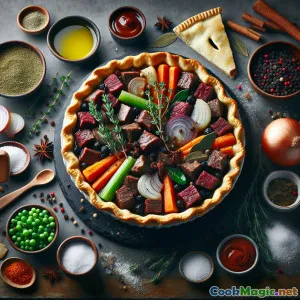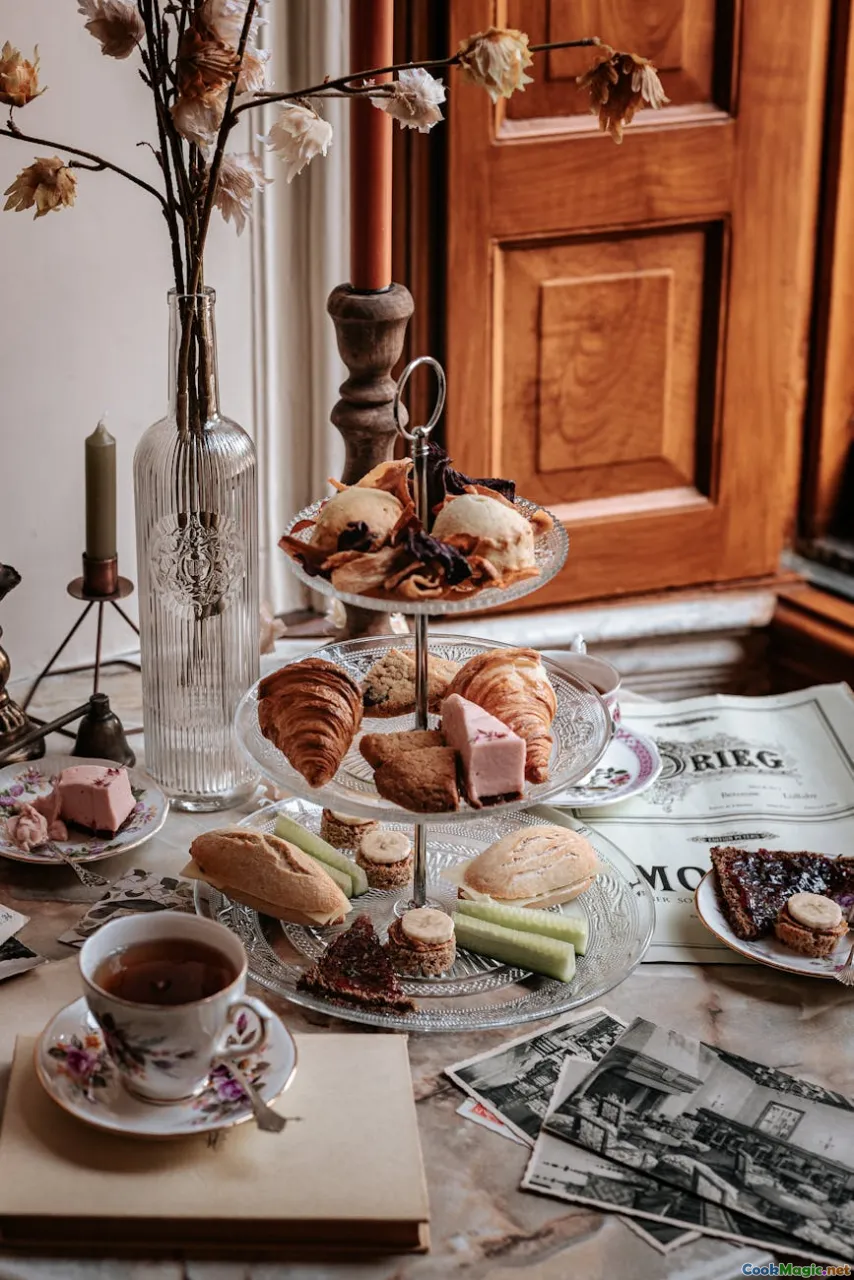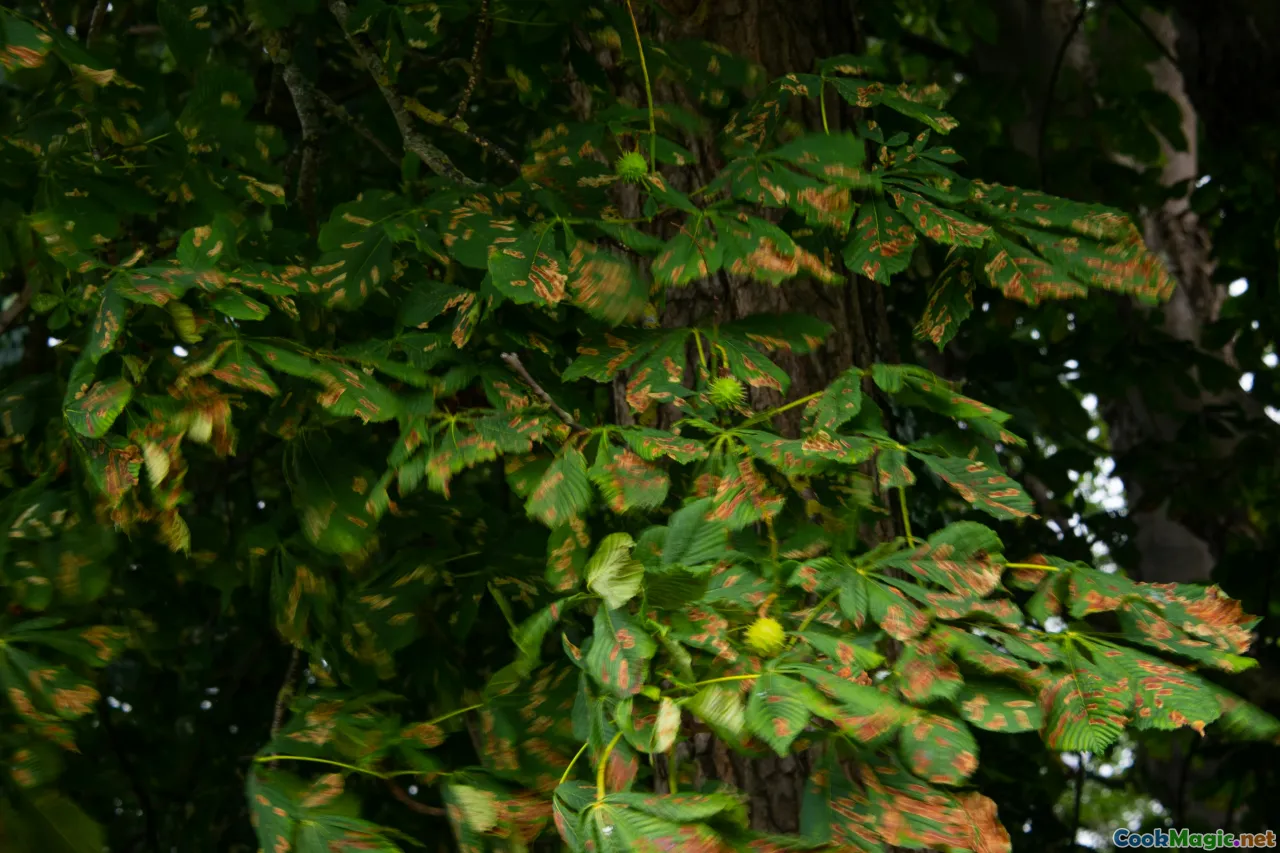
Kelezatan Pai Rusa Beraroma Juniper yang Pedesaan
(Rustic Juniper Infused Venison Pie Delight)
(0 Ulasan)0
3,114
Agustus 17, 2025
Laporkan Masalah
Bahan
-
750 grams Pundak rusa (potong dadu)
(Trimmed of sinew; substitute with beef if preferred)
-
2 tablespoons buah juniper
(Lightly crushed for aromatic flavor)
-
2 medium Bawang merah (dadu)
(Menambahkan rasa manis alami)
-
2 large Wortel ( iris tipis)
(Can add parsnips for extra earthiness)
-
2 pieces Batang seledri (diiris)
-
3 pieces Bawang putih, cincang halus
-
2 teaspoons Daun thyme segar
(Or use 1 teaspoon dried thyme)
-
2 pieces Daun salam
(Remove before assembling pie)
-
1 cup Anggur merah
(A robust English or French variety)
-
500 ml Kaldu daging sapi
(Or venison stock, low sodium)
-
1 tablespoon Pasta tomat
-
2 teaspoons Saus Worcestershire
-
2 tablespoons Tepung serbaguna
(For dusting the meat)
-
1 teaspoon Garam
(Sesuai selera)
-
0.5 teaspoon Lada hitam
(Malu segar yang digiling langsung)
-
2 tablespoons Minyak zaitun
-
500 grams adonan shortcrust
(Store-bought or homemade, enough for base and top)
-
1 piece Kuning telur (dikocok)
(Untuk glasir)
(Trimmed of sinew; substitute with beef if preferred)
(Lightly crushed for aromatic flavor)
(Menambahkan rasa manis alami)
(Can add parsnips for extra earthiness)
(Or use 1 teaspoon dried thyme)
(Remove before assembling pie)
(A robust English or French variety)
(Or venison stock, low sodium)
(For dusting the meat)
(Sesuai selera)
(Malu segar yang digiling langsung)
(Store-bought or homemade, enough for base and top)
(Untuk glasir)
Nutrisi
- Porsi: 6
- Ukuran Porsi: 1 Irisan (sekitar 300g)
- Calories: 710 kcal
- Carbohydrates: 45 g
- Protein: 35 g
- Fat: 33 g
- Fiber: 5 g
- Sugar: 7 g
- Sodium: 940 mg
- Cholesterol: 110 mg
- Calcium: 90 mg
- Iron: 5.8 mg
Instruksi
-
1 - Prepare the Venison:
Pat venison cubes dry. Toss with salt, pepper, and flour to evenly coat, shaking off excess.
-
2 - Brown the Meat:
Heat olive oil over medium-high in a large heavy-based pot. Brown venison in batches for rich color. Remove to a plate.
-
3 - Sauté Vegetables & Aromatics:
In the same pan, add onions, carrot, celery, and garlic. Sauté for 3–4 minutes until softened.
-
4 - Deglaze & Infuse:
Return venison to pot. Add red wine, scraping bottom for flavor. Stir in juniper berries, thyme, bay leaves, and tomato paste.
-
5 - Simmer the Stew:
Pour in beef stock and Worcestershire sauce. Bring to boil, reduce heat, and simmer covered 1 to 1.5 hours until venison is tender.
-
6 - Thicken & Cool:
Remove lid and bay leaves. Simmer uncovered 15–20 minutes. The sauce should be thick and glossy. Cool filling until room temp.
-
7 - Prepare Pastry:
Roll out 2/3 of the shortcrust pastry and line a greased pie dish, pressing into edges. Trim and chill the pastry-lined dish.
-
8 - Assemble Pie:
Fill pie base generously with cooled venison mix. Cover with remaining rolled pastry as lid. Crimp edges and cut a steam vent.
-
9 - Glaze & Bake:
Brush top with beaten egg yolk. Bake at 200°C (400°F) for 35–40 minutes until golden crisp and piping hot in center.
-
10 - Serve:
Cool slightly, slice, and serve hot with buttered greens or creamy mash.
Pat venison cubes dry. Toss with salt, pepper, and flour to evenly coat, shaking off excess.
Heat olive oil over medium-high in a large heavy-based pot. Brown venison in batches for rich color. Remove to a plate.
In the same pan, add onions, carrot, celery, and garlic. Sauté for 3–4 minutes until softened.
Return venison to pot. Add red wine, scraping bottom for flavor. Stir in juniper berries, thyme, bay leaves, and tomato paste.
Pour in beef stock and Worcestershire sauce. Bring to boil, reduce heat, and simmer covered 1 to 1.5 hours until venison is tender.
Remove lid and bay leaves. Simmer uncovered 15–20 minutes. The sauce should be thick and glossy. Cool filling until room temp.
Roll out 2/3 of the shortcrust pastry and line a greased pie dish, pressing into edges. Trim and chill the pastry-lined dish.
Fill pie base generously with cooled venison mix. Cover with remaining rolled pastry as lid. Crimp edges and cut a steam vent.
Brush top with beaten egg yolk. Bake at 200°C (400°F) for 35–40 minutes until golden crisp and piping hot in center.
Cool slightly, slice, and serve hot with buttered greens or creamy mash.
Informasi Lebih Lanjut: Kelezatan Pai Rusa Beraroma Juniper yang Pedesaan
Juniper Venison Pie: A British Game Tradition
Juniper Venison Pie is a truly distinguished dish—a hearty English classic, with roots deep in Britain’s game cooking heritage. This creation epitomizes rustic comfort, fusing delicate flavors of wild venison and piney juniper into a robust stew that's enveloped in golden, buttery shortcrust pastry. Whether enjoyed in a countryside pub, a festive holiday table, or as the centerpiece of a hearty winter supper, this pie represents the very best of English culinary tradition.
History & Cultural Roots
Pies—especially ones filled with meat—are a cornerstone of British cuisine. For centuries, pies served as both a preservation method and a practical mean to serve large quantities at feasts. Game pies, historically reserved for the upper classes, featured in lavish Victorian banquets with elaborate patterns and multiple types of meat. Venison, the prized meat of deer, embodies the wild bounty of British forests, and juniper berries (native to these regions) provided not only flourishes of flavor, but also helped mask stronger, gamey notes.
The addition of juniper is more than just British tradition; the botanical's resinous, woodsy flavor is synonymous with flavors of wild game all over Northern Europe. When combined with aromatics, root vegetables, and a sturdy crust, it transforms into a dish that’s as sustaining as it is elegant.
Crafting the Pie: Tips & Tricks
1. The Meat: For best results, use shoulder or haunch of venison, well-trimmed and diced. Venison's leanness means longer, slower moist cooking, so don't rush it—let those tough but flavorful cuts break down in gentle heat.
2. Juniper Berries: Lightly crush them to unleash their raw, piney aroma, but don’t overdo it—a little goes a long way.
3. Balancing Flavors: The addition of root vegetables lends gentle sweetness, balancing the wine and the slightly bitter note from juniper, while fresh thyme and bay entwine everything vegetal and woodsy into the sauce.
4. Pastry Tips: Use your favorite shortcrust, but make sure both base and top are chilled before filling to prevent a soggy crust. Brushing the top with egg yolk yields the best shine and color.
5. Make-Ahead: The pie filling can—and should—be made a day in advance. This resting time allows flavors to deepen and develop texture.
Why It's Unique
What makes this pie extraordinary is its bold use of juniper paired with venison—bridging flavors of wild British woodland and sophisticated European tradition. There’s something almost primeval about this pairing; Northern cooks have long turned to fragrant hedgerow picks like juniper to pair with rich hunted meats.
You’ll also find this recipe broad in its adaptability: while classically British, the idea travels well—Scandinavians, Germans, and even some French chefs have similar traditions—making this pie a shining example of shared culinary DNA.
Serving & Sharing
Serve Juniper Venison Pie alongside peppery watercress, buttered savoy cabbage, or cloud-soft mashed potatoes. A glass of hearty red wine or English ale wouldn’t go amiss. If you’re specifically celebrating the British shooting season (late autumn to winter), it’s a vivid reminder of ancient, storied foodways that live on in contemporary kitchens.
Final Thoughts
A slice of Juniper Venison Pie is like a postcard from an English woodland—a celebration of game, of gathering, and old English know-how. This is versatility and comfort, masquerading in a rich, golden crust, bound to leave your guests as enchanted as the British countryside itself. Use wild venison if you can source it; it’s earthier and truer in flavor. Don’t skimp on the juniper—even a gentle pine-laced edge makes the dish sing with wild simplicity.
For those uninitiated in game cooking, this pie is the perfect introduction. Let your pie rest slightly before serving—it’s part of the magic. Each mouthful speaks of firesides, ancestry, and the deep satisfaction that only a well-made pie can bring.

























